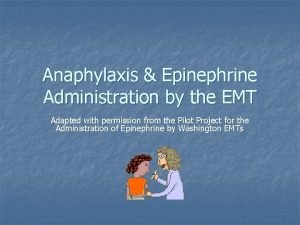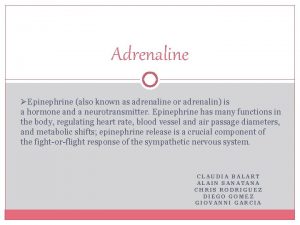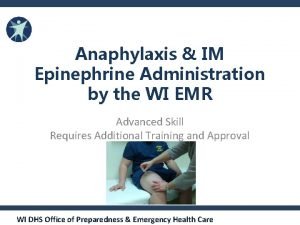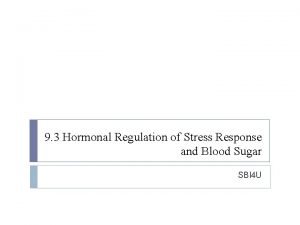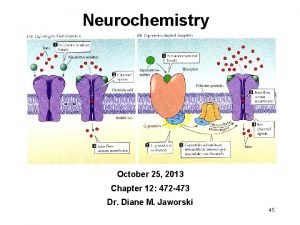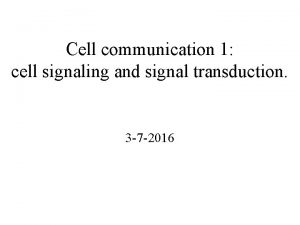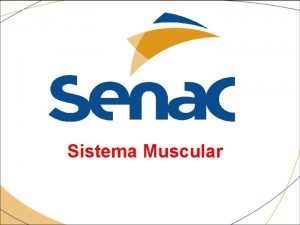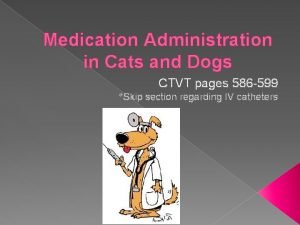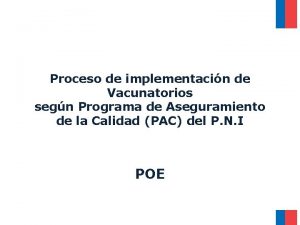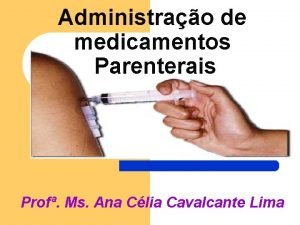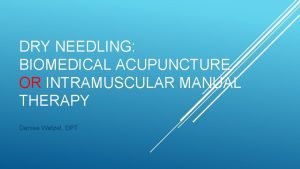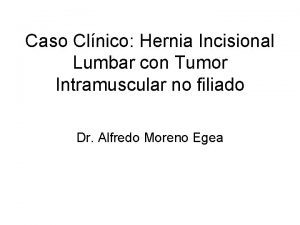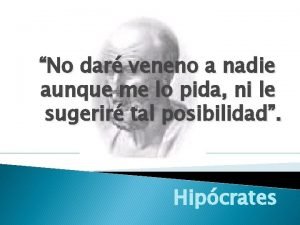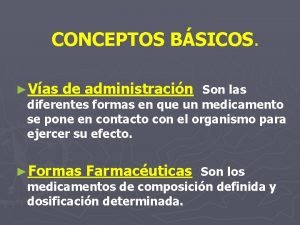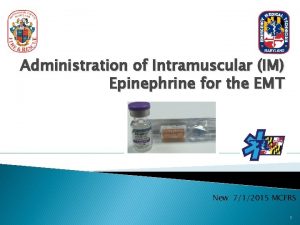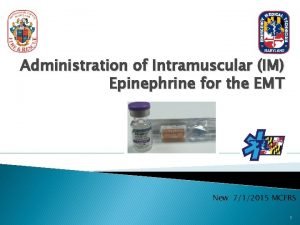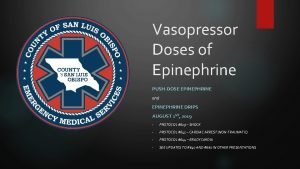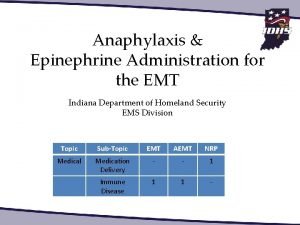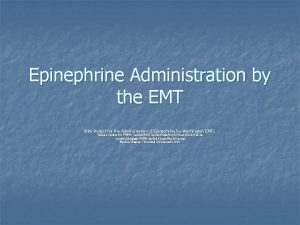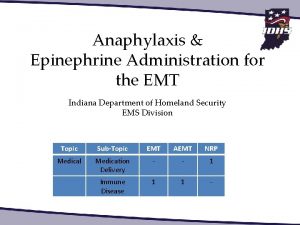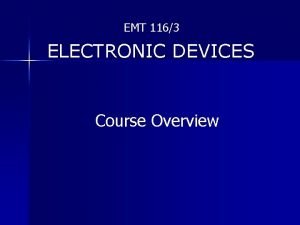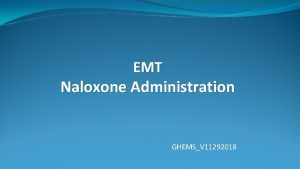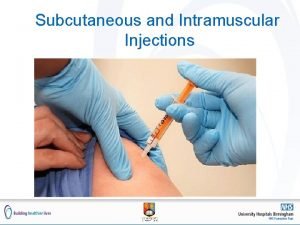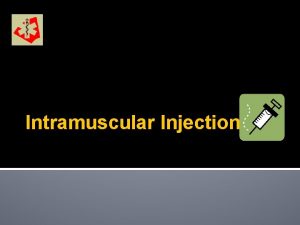Administration of Intramuscular IM Epinephrine for the EMT


























- Slides: 26

Administration of Intramuscular (IM) Epinephrine for the EMT New 7/1/2015 MCFRS 1

Objectives � The providers will summarize the need for this change from an epinephrine auto injector � The provider will define the proper dosage of epinephrine for the adult and pediatric patient for the following medical situations. ◦ Asthma ◦ Allergic Reaction ◦ Anaphylaxis � Drawing up the medication � The student will be able to carry out the administering of the medication 2

Objectives (con’t) Ø The student will be able to summarize the protocols for the following medical situations that will require the administration of IM epinephrine: • Asthma • Allergic Reaction • Anaphylaxis 3

Epinephrine/Adrenalin Reference: Maryland Medical Protocol 2015 • Pharmacology • The administration of epinephrine causes increases in: • • Systemic vascular resistance Systemic arterial pressure Heart rate Increase contractility Increases myocardial oxygen requirement Cardiac automaticity AV conduction • Causes bronchial dilation by smooth muscle relaxation 4

Epinephrine/Adrenalin (con’t) Reference: Maryland Medical Protocol 2015 • Indications • Moderate to severe allergic reaction with respiratory distress or mild allergic reaction with history of lifethreatening allergic reaction • Pediatric patients with severe asthma • Contraindications • None in the presence of anaphylaxis • Used with caution for pregnant patients 5

Epinephrine/Adrenalin (con’t) Reference: Maryland Medical Protocol 2015 • Adverse Effects • • Tachycardia/Palpitations Angina Headache Nausea/vomiting Dizziness Hypertension Nervousness/anxiety Tremors • Dosage • Adult (Over age 3) 0. 3 mg IM • Pediatric (under age 3) 0. 15 mg IM 6

Maryland Medical Protocols 7

Protocol Review – Allergic Reaction • Types/levels of Reaction • Mild: Local swelling & itching at the site • Moderate: Hives & mild wheezing • Severe: Diffuse wheezing, pharyngeal swelling, dyspnea, hypoperfusion, abnormal skin color, stridor, and/or loss of peripheral pulses 8

Protocol Review – Allergic Reaction 9

Protocol Review – Asthma/COPD Presentation: Patient may exhibit any of the following: wheezing and/or crackles, abnormal respiratory rate, rapid heart rate, stridor, grunting, cyanosis, mottled skin, altered mental status, nasal flaring, retractions, accessory muscle use, dyspnea, diminished or absent breath sounds, and/or tripod positioning. 3. Treatment CONSIDER MEDICAL CONSULTATION FOR PATIENTS GREATER THAN 45 YEARS OF AGE OR PATIENTS WITH A CARDIAC ISTORY. 10

Protocol Review – Asthma/COPD a) Assist the patient experiencing moderate to severe or mild symptoms with a history of life-threatening allergic reaction with the patient’s prescribed or EMS epinephrine auto-injector or patient’s prescribed fast-acting bronchodilator b) Use of the EMS services Epinephrine auto-injector/IM injection requires medical consultation c) Albuterol inhaler (2 puffs) may be repeated once within 30 minutes d) Consider additional doses of patients prescribed fast acting bronchodilator or Epinephrine auto-injector/IM injection 11

Protocol Review – Asthma/COPD (n) Assist the patient experiencing moderate to severe or mild symptoms with a history of life-threatening allergic reaction with the patient’s prescribed or EMS epinephrine autoinjector/IM injection or patient’s prescribed fast-acting bronchodilator MEDICAL CONSULTATION IS REQUIRED IF TH EPATIENT HAS CONGENITAL HEART OR CHRONIC LUNG DISEASE (o) Fast-acting bronchodilators (2 puffs) may be repeated once within 30 minutes (p) Consider additional doses of patients fast-acting bronchodilator or epinephrine auto-injector/IM injection 12

Protocol Review – Overdose/Poisoning: Injection Protocol Review – Asthma/COPD 13

Dosage of Epinephrine � The same dosage as currently administered from an auto injector ◦ Adult Dosage: � 0. 3 mg �any patient 3 years of age or older ◦ Pediatric Dosage � 0. 15 mg �less than 3 years of age 14

Where do I give the Intramuscular Injection � Deltoid Muscle (Upper arm muscle): Completely expose the upper arm. You will give the injection in the center of an upside down triangle. Feel for the bone that goes across the top of the upper arm (acromion process). The bottom of it will form the base of the triangle. The point of the triangle is directly below the middle of the base at about the level of the armpit. The correct area to give an injection is in the center of the triangle, 1 to 2 inches below the acromion process. This site should not be used if the person is very thin or the muscle is very small. 15

Where do I give the Intramuscular Injection � Alternate location: Lateral middle aspect of the thigh (same as auto injector) 16

Parts of a Syringe � Co ver There are 3 parts to a syringe: ◦ Safety. Glide: Safety shield to cover Saf Ne ety ◦ The contaminated needle. ◦ Needle: The needle goes into the muscle. 25 ga. 1” (2 per kit) Barr ◦ Barrel: The barrel holds the ell medicine and has markings on it like a ruler. The markings are in milliliters (m. L). ◦ Plunger: The plunger is used to get medicine into and out of the r syringe. ge Gli d ed le e n u Pl 17

How do I draw up the Epinephrine � Identify the medical need for the IM Injection � Select the Epi 1: 1. 000 ampule � Verify the expiration date is still valid � Check and verify the medication order at least 4 times before administering: ◦ 1. When removing from drug kit ◦ 2. When preparing the medication for administration ◦ 3. Just before administering the medication to the patient ◦ 4. Immediately following the injection 18

Ampule Tap down any medication from the top of the ampule (figure 1) � With a gauze pad, snap off the ampule top at the scored neck (figure 2 & 3) � Invert ampule and insert 1 cc syringe into ampule � Draw up the desired dose from the ampule � figure 1 figure 2 (figure 4) Cap remove and then dispose of the needle from the syringe � Open the new needle from the packaging and push onto syringe. Do not remove cap over the needle � figure 3 figure 4 19

Single-Use Vial � Snap off the top of the single-use vial & 3) (figure 2 Invert Single-Use Vial and insert 1 cc syringe into vial � Pull back on the plunger and draw up the desired dose from the vial (figure 2) � Pull the syringe out of the vial and secure the Safety. Glide cap, twist needle off of syringe in a counter clockwise twist and then dispose of the needle from the syringe in a sharps container � Open the new needle from the packaging and twist clockwise onto the syringe. Do not remove cap over the needle yet � figure 1 figure 2 20

How Do I Give An Intramuscular Injection? � � Prepare the Site: Open the alcohol wipe: Wipe the area where you plan to give the injection in a circular motion. Let the area dry. Do not touch this area until you give the injection. Prepare the needle: Hold the syringe with your writing hand pull the cover off with your other hand. Place the syringe between your thumb and first finger. Let the barrel of the syringe rest on your second finger. Hold the skin around where you will give the injection: With your free hand, gently press on and pull the skin so that it is slightly tight. Insert the needle into the muscle: Hold the syringe barrel tightly and use your wrist to inject the needle through the skin and into the muscle at a 90 degree angle. 21

How to, continued � Check the needle: Let go of the skin with your other hand. Hold the syringe so it stays pointed straight in. � Inject the medicine: Push down on the plunger to inject the medicine. Do not force the medicine by pushing hard. Some medicines hurt. You can inject the medicine slowly to reduce the pain. � Remove the needle: Once the medicine is injected, remove the needle at the same angle as it went in. Slide the Safety. Glide forward to cover the needle. Dispose in sharps container. � Place gauze over the area where you gave the injection. 22

How to, continued � Place a sterile gauze over site and apply slight pressure. � Bandage site � Document the time, dosage and location of the medication administration � Re-assess the patients response to the medication: ◦ Improvement: �Decreased effort to breath �Decreased swelling in airway ◦ No Change or s/s worsening �Consult for additional dose of IM epinephrine 23

Restocking � � When restocking at the hospital do not accept multi-dose vials. The vial must be 1 mg Epinephrine in 1 ML. If the hospital does not have the 1. omg/1 cc ampule or vial restock from your station. Restock the following items: ◦ ◦ ◦ One 1. 0 mg/1 cc ampule/vial of epinephrine One 1 cc syringe Luer-Lok tip Two 25 ga. 1” safety needles Two alcohol preps Two 2 x 2 gauze pads 24

Review � Why was this change made from auto injectors to syringes? � Maryland Medical protocols � What are the landmarks for the primary and secondary injection sites � What do you need to administer IM epinephrine � What do you need to restock, and what don’t you take if offered? 25

For questions please contact the on-duty EMS officer. 26
 Epinephrine dosage emt
Epinephrine dosage emt Racemic epinephrine
Racemic epinephrine Epi pen
Epi pen Epinephrine function
Epinephrine function Adrenaline is also known as
Adrenaline is also known as Recemic epinephrine
Recemic epinephrine Epinephrine and norepinephrine feedback loop
Epinephrine and norepinephrine feedback loop Dose of epinephrine in anaphylaxis
Dose of epinephrine in anaphylaxis Hypothalamus epinephrine
Hypothalamus epinephrine Emt 6 rights
Emt 6 rights Http://learn.genetics.utah.edu/content/addiction/
Http://learn.genetics.utah.edu/content/addiction/ Epinephrine function
Epinephrine function Epinephrine second dose
Epinephrine second dose Epinephrine cascade
Epinephrine cascade Msculos
Msculos Via intramuscular
Via intramuscular Im vasto lateral
Im vasto lateral Intramuscular injection sites in dogs and cats
Intramuscular injection sites in dogs and cats Sexing rabbits
Sexing rabbits Que es una inyección intramuscular
Que es una inyección intramuscular Subcutânea bisel para cima ou para baixo
Subcutânea bisel para cima ou para baixo Biomedical dry needling
Biomedical dry needling Zona de puncion intramuscular
Zona de puncion intramuscular Islam
Islam Inyeccion intramuscular
Inyeccion intramuscular Infraglutea
Infraglutea Vía intramuscular
Vía intramuscular
